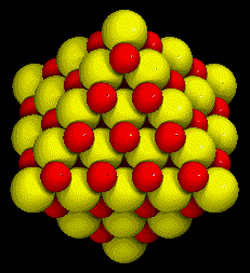Nuclei Affect the Bounce of

A molecule’s atomic nuclei don’t usually have much effect on its interactions with other atoms and molecules. Chemical reactions, for example, involve only the external electrons. But the alignment of the nuclear spins can affect the rotation of a diatomic molecule like Now a report in the 21 December PRL shows that this alignment strongly affects even a simple scattering experiment, where hydrogen molecules bounce off the surface of a crystal. The experiment may also provide a new method for probing the electric field structures of surfaces.
Each hydrogen atom consists of only a proton and an electron, and the two protons’ spins in an molecule are either aligned (ortho-hydrogen) or oppositely directed (para-hydrogen). Quantum mechanics requires that the quantum state of the molecule have an overall “anti-symmetry,” or sign change if the protons are interchanged, but the total symmetry is affected by both the spin alignment and the rotational motion. The result is that the tumbling motion of the molecule is not only quantized, but restricted to certain values of angular momentum that have the correct symmetry properties: Para-hydrogen always has an even integer number of units of rotational angular momentum, while ortho-hydrogen has an odd number. Of course, these rules apply to any diatomic molecule, such as , but heavier molecules are much harder to separate into pure beams of a single type, so the effects cannot normally be detected.
Crystalline lithium fluoride (LiF) has been used since the 1930s to study quantum properties of matter because it’s easily split to reveal ideal surfaces that can be kept clean at the atomic level. There is so much experience with scattering molecular beams from this surface, according to J. Peter Toennies, of the Max Planck Institute for Fluid Dynamics in Göttingen, Germany, that “we thought we knew everything about LiF.” But Geert-Jan Kroes, of Leiden University in the Netherlands recently predicted a significant difference in the scattering of ortho- and para-hydrogen from LiF and prodded Toennies to look for the effect experimentally.
Toennies, Kroes, and their colleagues have now confirmed the prediction by comparing the scattering of pure para-hydrogen with that of normal hydrogen, which is 75% ortho. The team measured the number of scattered molecules reaching each angular position around the crystal and found the expected differences between the two types of beams. The explanation, according to the authors, is that the charge distributions in the two types of hydrogen interact differently with the electric field at the LiF surface. Some of the ortho molecules, for example, tend to amplify the peaks and valleys of the LiF field, while other orientations tend to smooth out the effects of the field. Toennies says that these field interactions can be exploited to measure the field undulations on other surfaces in a more direct way than has been possible previously.
“It’s a fascinating paper,” says Joseph Manson of Clemson University in South Carolina. “This is a step up in our ability to measure subtle [variations] in the electric field” on surfaces, he says, because the field variations are usually difficult to separate from other effects.


